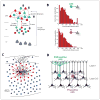The logic of inhibitory connectivity in the neocortex
- PMID: 22922685
- PMCID: PMC4133777
- DOI: 10.1177/1073858412456743
The logic of inhibitory connectivity in the neocortex
Abstract
Although inhibition plays a major role in the function of the mammalian neocortex, the circuit connectivity of GABAergic interneurons has remained poorly understood. The authors review recent studies of the connections made to and from interneurons, highlighting the overarching principle of a high density of unspecific connections in inhibitory connectivity. Whereas specificity remains in the subcellular targeting of excitatory neurons by interneurons, the general strategy appears to be for interneurons to provide a global "blanket of inhibition" to nearby neurons. In the review, the authors highlight the fact that the function of interneurons, which remains elusive, will be informed by understanding the structure of their connectivity as well as the dynamics of inhibitory synaptic connections. In a last section, the authors describe briefly the link between dense inhibitory networks and different interneuron functions described in the neocortex.
Keywords: GABAergic; connectivity; inhibition; interneurons; networks.
Conflict of interest statement
The author(s) declared no potential conflicts of interest with respect to the research, authorship, and/or publication of this article.
Figures





Similar articles
-
Autaptic self-inhibition of cortical GABAergic neurons: synaptic narcissism or useful introspection?Curr Opin Neurobiol. 2014 Jun;26:64-71. doi: 10.1016/j.conb.2013.12.009. Epub 2014 Jan 14. Curr Opin Neurobiol. 2014. PMID: 24434607 Review.
-
Principles of connectivity among morphologically defined cell types in adult neocortex.Science. 2015 Nov 27;350(6264):aac9462. doi: 10.1126/science.aac9462. Science. 2015. PMID: 26612957 Free PMC article.
-
Dense, unspecific connectivity of neocortical parvalbumin-positive interneurons: a canonical microcircuit for inhibition?J Neurosci. 2011 Sep 14;31(37):13260-71. doi: 10.1523/JNEUROSCI.3131-11.2011. J Neurosci. 2011. PMID: 21917809 Free PMC article.
-
Functional Logic of Layer 2/3 Inhibitory Connectivity in the Ferret Visual Cortex.Neuron. 2019 Nov 6;104(3):451-457.e3. doi: 10.1016/j.neuron.2019.08.004. Epub 2019 Sep 5. Neuron. 2019. PMID: 31495646 Free PMC article.
-
GABAergic Interneurons in the Neocortex: From Cellular Properties to Circuits.Neuron. 2016 Jul 20;91(2):260-92. doi: 10.1016/j.neuron.2016.06.033. Neuron. 2016. PMID: 27477017 Free PMC article. Review.
Cited by
-
Functional network overlap as revealed by fMRI using sICA and its potential relationships with functional heterogeneity, balanced excitation and inhibition, and sparseness of neuron activity.PLoS One. 2015 Feb 25;10(2):e0117029. doi: 10.1371/journal.pone.0117029. eCollection 2015. PLoS One. 2015. PMID: 25714362 Free PMC article.
-
Suppression of Low-Frequency Gamma Oscillations by Activation of 40-Hz Oscillation.Cereb Cortex. 2022 Jun 16;32(13):2785-2796. doi: 10.1093/cercor/bhab381. Cereb Cortex. 2022. PMID: 34689202 Free PMC article.
-
Long-latency suppression of auditory and somatosensory change-related cortical responses.PLoS One. 2018 Jun 26;13(6):e0199614. doi: 10.1371/journal.pone.0199614. eCollection 2018. PLoS One. 2018. PMID: 29944700 Free PMC article.
-
When Elderly Outperform Young Adults-Integration in Vision Revealed by the Visual Mismatch Negativity.Front Aging Neurosci. 2017 Jan 31;9:15. doi: 10.3389/fnagi.2017.00015. eCollection 2017. Front Aging Neurosci. 2017. PMID: 28197097 Free PMC article.
-
Neocortical somatostatin neurons reversibly silence excitatory transmission via GABAb receptors.Curr Biol. 2015 Mar 16;25(6):722-731. doi: 10.1016/j.cub.2015.01.035. Epub 2015 Feb 26. Curr Biol. 2015. PMID: 25728691 Free PMC article.
References
-
- Beierlein M, Gibson JR, Connors BW. Two dynamically distinct inhibitory networks in layer 4 of the neocortex. J Neurophysiol. 2003;90:2987–3000. - PubMed
Publication types
MeSH terms
Grants and funding
LinkOut - more resources
Full Text Sources

